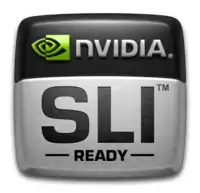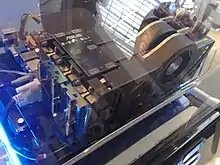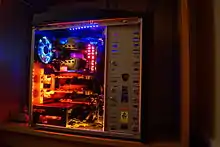Scalable Link Interface
Scalable Link Interface (SLI) is a brand name for a multi-GPU technology developed by Nvidia for linking two or more video cards together to produce a single output. SLI is a parallel processing algorithm for computer graphics, meant to increase the available processing power.[1]
 | |
| Manufacturer | Nvidia |
|---|---|
| Type | Multi-GPU technology |
| Release date | 2004 |
| Predecessor | Scan-Line Interleave |
| Successor | NVLink |
The initialism SLI was first used by 3dfx for Scan-Line Interleave, which was introduced to the consumer market in 1998 and used in the Voodoo2 line of video cards. After buying out 3dfx, Nvidia acquired the technology but did not use it. Nvidia later reintroduced the SLI name in 2004 and intended for it to be used in modern computer systems based on the PCI Express (PCIe) bus; however, the technology behind the name SLI has changed dramatically.


Implementation
SLI allows two, three, or four graphics processing units (GPUs) to share the workload when rendering real-time 3D computer graphics. Ideally, identical GPUs are installed on the motherboard that contains enough PCI Express slots, set up in a master–slave configuration. All graphics cards are given an equal workload to render, but the final output of each card is sent to the master card via a connector called the SLI Bridge. For example, in a two graphics card setup, the master works on the top half of the scene, the slave the bottom half. Once the slave is done, it sends its render to the master to combine into one image before sending it to the monitor.
The SLI bridge is used to reduce bandwidth constraints and send data between both graphics cards directly. It is possible to run SLI without using the bridge connector on a pair of low-end to mid-range graphics cards (e.g. 7100GS or 6600GT) with Nvidia's Forceware drivers 80.XX or later. Since these graphics cards do not use as much bandwidth, data can be relayed through just the chipsets on the motherboard. However, if there are two high-end graphics cards installed and the SLI bridge is omitted, the performance will suffer severely, as the chipset does not have enough bandwidth.
Configurations currently include:
- 2-Way, 3-Way, and 4-Way SLI. Uses two, three, or four individual graphics cards respectively.
- Two GPUs on one graphics card. Examples include the GeForce GTX 590, GeForce GTX 690 and the GeForce GTX Titan Z. This configuration has the advantage of implementing Two-Way SLI, while only occupying one PCI-Express slot and (usually) two expansion I/O slots. This also allows for Four-Way SLI using only two cards (which is referred to as Quad SLI).
Nvidia has created a set of custom video game profiles in cooperation with video game publishers that will automatically enable SLI in the mode that gives the largest performance boost.
Nvidia has 3 types of SLI bridges:
- Standard Bridge (400 MHz Pixel Clock[2] and 1GB/s bandwidth[3])
- LED Bridge (540 MHz Pixel Clock[4])
- High-Bandwidth Bridge (650 MHz Pixel Clock and 2GB/s Bandwidth[5])
The Standard Bridge is traditionally included with motherboards that support SLI and is recommended for monitors up to 1920×1080 and 2560×1440@60 Hz. The LED Bridge is sold by Nvidia,[6] EVGA,[7] and others and is recommended for monitors up to 2560×1440@120 Hz+ and 4K. The LED Bridges can only function at the increased Pixel Clock if the GPU supports that clock. The High-Bandwidth Bridge is only sold by Nvidia[8] and is recommended for monitors up to 5K and Surround.
The following table provides an overview on the maximum theoretical bandwidth for data transfers depending on bridge type specifications as found on the open market:[9]
| Clock Rate | 400 MHz | 540 MHz | 650 MHz |
|---|---|---|---|
| single channel | 1 GB/s | 1,35 GB/s | 1,625 GB/s |
| dual channel | 2 GB/s | 2,7 GB/s | 3,25 GB/s |
SLI Modes
Split Frame Rendering (SFR)
This analyzes the rendered image in order to split the workload equally between the two GPUs. To do this, the frame is split horizontally in varying ratios depending on geometry. For example, in a scene where the top half of the frame is mostly empty sky, the dividing line will lower, balancing geometry workload between the two GPUs.
Alternate Frame Rendering (AFR)
Each GPU renders entire frames in sequence. For example, in a Two-Way setup, one GPU renders the odd frames, the other the even frames, one after the other. Finished outputs are sent to the master for display. Ideally, this would result in the rendering time being cut by the number of GPUs available. In their advertising, Nvidia claims up to 1.9x the performance of one card with the Two-Way setup. While AFR may produce higher overall framerates than SFR, it also exhibits the temporal artifact known as Micro stuttering, which may affect frame rate perception. It is noteworthy that while the frequency at which frames arrive may be doubled, the time to produce the frame is not reduced - which means that AFR is not a viable method of reducing input lag.
SLI Antialiasing
This is a standalone rendering mode that offers up to double the antialiasing performance by splitting the antialiasing workload between the two graphics cards, offering superior image quality. One GPU performs an antialiasing pattern which is slightly offset to the usual pattern (for example, slightly up and to the right), and the second GPU uses a pattern offset by an equal amount in the opposite direction (down and to the left). Compositing both the results gives higher image quality than is normally possible. This mode is not intended for higher frame rates, and can actually lower performance, but is instead intended for games which are not GPU-bound, offering a clearer image in place of better performance. When enabled, SLI Antialiasing offers advanced antialiasing options: SLI 8X, SLI 16X, and SLI 32x (for Quad SLI systems only).[10]
Hybrid SLI
Hybrid SLI is the generic name for two technologies, GeForce Boost and HybridPower.[11]
GeForce Boost allowed the rendering power of an IGP and a discrete GPU to be combined in order to increase performance.[11]
HybridPower, on the other hand, is another mode that is not for performance enhancement. The setup consists of an IGP as well as a GPU on MXM module. The IGP would assist the GPU to boost performance when the laptop is plugged to a power socket while the MXM module would be shut down when the laptop was unplugged from power socket to lower overall graphics power consumption.[12][13] Hybrid SLI is also available on desktop Motherboards and PCs with PCI-E discrete video cards. NVIDIA claims that twice the performance can be achieved with a Hybrid SLI capable IGP motherboard and a GeForce 8400 GS video card.[14][15]
HybridPower was later renamed as Nvidia Optimus.
SLI HB
In May 2016 Nvidia announced that the GeForce 10 series would feature a new SLI HB (High Bandwidth) bridge; this bridge uses 2 SLI fingers on the PCB of each card and essentially doubles the available bandwidth between them. Currently, only GeForce 10 series cards support SLI HB and only 2-way SLI is supported over this bridge for single-GPU cards. SLI HB interface runs at 650 MHz, while legacy SLI interface runs at slower 400 MHz.
Electrically there is little difference between the regular SLI bridge and the SLI HB bridge. It is similar to two regular bridges combined in one PCB. The signal quality of the bridge improved, however, as the SLI HB bridge has an adjusted trace-length to make sure all traces on the bridge have exactly the same length.[16]
A PC gaming magazine has done research with x-rays for comparing SLI bridges with their SLI HB successors and found adjusted signal lengths by planned Meandering of certain wires so that clock rates can go up from 400 MHz to 650 MHz and thus the data rates along with that. With the increased bus width a noticeable bandwidth increase should be expected. Tests with a GTX 1080 GPU-board model showed that the improvements in gaming performance is quite marginal. Other than that it was discovered or determined, that LED illuminated bridges (often back-side-illuminating some logo) will mainly result in a noticeable increased market price at a comparable base functionality.[17]
Caveats
- Not all motherboards with multiple PCI-Express x16 slots support SLI. On August 10, 2009 Nvidia announced that Intel and other leading motherboard manufacturers including ASUS, EVGA, Gigabyte and MSI have all licensed Nvidia SLI technology for inclusion on their Intel P55 Express Chipset-based motherboards designed for the upcoming Intel Core i7 and i5 processor in the LGA 1156 socket.[18] Older motherboards using the P55's predecessors Intel P35 or Intel P45 DO NOT support SLI.
Recent motherboards as of October 2017 that support it are Intel's Z and X series chipsets (Z68, Z77, Z87, Z97, Z170, Z270, Z370, X79, X99 and X299) along with AMD's 990FX, X370 and X399 chipsets.[19] Earlier chipsets, such as the Intel X58, could support 2-way SLI over 16 lane PCI-e. In order for motherboards of that generation to support more than two GPUs they were required to implement Nvidia nForce chipsets. - In an SLI configuration, cards can be of mixed manufacturers, card model names, BIOS revisions or clock speeds. However, they must be of the same GPU series (e.g. 8600, 8800) and GPU model name (e.g. GT, GTS, GTX).[20] There are rare exceptions for "mixed SLI" configurations on some cards that only have a matching core codename (e.g. G70, G73, G80, etc.), but this is otherwise not possible, and only happens when two matched cards differ only very slightly, an example being a differing amount of video memory, stream processors, or clockspeed. In this case, the slower/lesser card becomes dominant, and the other card matches. Another exception is the GTS 250, which can be paired with the 9800 GTX+, as the GTS 250 GPU is a rebadged 9800 GTX+ GPU.
- In cases where two cards are not identical, the faster card – or the card with more memory - will run at the speed of the slower card or disable its additional memory. (Note that while the FAQ still claims different memory size support, the support has been removed since revision 100.xx of Nvidia's Forceware driver suite.)[20]
- SLI does not always give a performance benefit – in some extreme cases, it can lower the frame rate due to the particulars of an application's coding.[21] This is also true for AMD's CrossFire, as the problem is inherent in multi-GPU systems. This is often witnessed when running an application at low resolutions.
- Vsync + Triple buffering is not supported in some cases in SLI AFR mode.
- Users having a Hybrid SLI setup must manually change modes between HybridPower and GeForce Boost, while automatically changing mode will not be available until future updates become available. Hybrid SLI currently supports only single link DVI at 1920×1200 screen resolution.[22]
- When using SLI with AFR, the subjective framerate can often be lower than the framerate reported by benchmarking applications, and may even be poorer than the framerate of its single-GPU equivalent. This phenomenon is known as micro stuttering and also applies to CrossFire since it is inherent to multi-GPU configurations.[23]
- With the new RTX 20xx series of graphics cards as launched in 2018 the interconnect is no longer SLI HB. These newer cards are using NVLink as its communication base and require either a 3 slot long or 4 slot long NVLink bridge - reasoned partially by thermal considerations and by socket availability. As of now only two GPU cards can be connected with NVLink; three-way, four-way and quad are not possible using NVLink bridges even if NVLink by principle is a very versatile interface.[24]
- As of the GeForce RTX 3000-series, SLI has been effectively replaced with NV-LINK[25]
See also
- Scan-Line Interleave by 3Dfx
- AMD CrossFireX – AMD's competing solution
- MultiChrome
- Micro stuttering
- Conventional PCI
- NVLink Bridge - newer technology for connecting pairs of GeForce RTX 20 series cards, based on NVLink interface.[24]
References
- "What is SLI?". www.geforce.com. Retrieved 24 November 2014.
- "[EVGA] New Pro SLI Bridges V2". Overclock.net.
- "SLI - FAQ - GeForce". www.geforce.com.
- "[EVGA] New Pro SLI Bridges V2". Overclock.net.
- "Nvidia GeForce GTX 1080 Pascal Display Pipeline & SLI". 17 May 2016.
- "NVIDIA SLI Bridges - GeForce". www.geforce.com.
- "EVGA - Articles - EVGA Pro SLI Bridges V2". EVGA.
- "GeForce GTX 1080 Graphics Cards from NVIDIA GeForce". NVIDIA.
- https://www.pcgameshardware.de/Pascal-Codename-265448/News/HB-SLI-Bruecke-Unterschiede-1204297/
- "Introducing SLI Antialiasing: The Ultimate in Visual Quality". www.nvidia.com. Retrieved 24 November 2014.
- "Hybrid SLI Technology". www.nvidia.com. Retrieved 23 March 2015.
- Valich, Theo (2007-06-26). "NVIDIA's Hybrid SLI attacks AMD's PowerXPress". The Inquirer. Archived from the original on 2007-10-04. Retrieved 2007-09-26.
- Shilov, Anton (2007-06-25). "NVIDIA Readies Hybrid SLI Technology". X-bit labs. Retrieved 2007-10-17.
- Abazovic, Faud (2007-08-08). "Hybrid SLI first for AMD". Archived from the original on 2007-11-14. Retrieved 2007-10-17.
- "Growth Opportunities" (PDF). NVIDIA. 2007-06-20. p. 9. Retrieved 2007-10-17.
- "NVIDIA HB SLI Bridge: A Technical Review - Overclocking.Guide". 2016-08-11. Retrieved 2016-08-11.
- https://www.pcgameshardware.de/Pascal-Codename-265448/News/HB-SLI-Bruecke-Unterschiede-1204297/
- "NVIDIA SLI Technology Now Licensed For INTEL Core I7 And Core I5 Platforms".
- "Motherboards". NVIDIA. Retrieved 2016-05-16.
- "SLI FAQs". NVIDIA. Retrieved 2008-12-04.
- Kreiss, Tino; Töpelt, Bert; Schuhmann, Daniel (2005-12-02). "Performance Comparison Between Single Configurations And SLI Setups". Tom's Hardware. Retrieved 2007-06-01.
- Bit-Tech interview (page 2), retrieved January 23, 2008
- Raffael Vötter (2008-02-08). "Video proof: Micro stuttering may destroy the performance gains from current multi GPU technologies". PC Games Hardware Online. Retrieved 2009-11-03.
- "NVIDIA GeForce RTX 2080 Founders Edition Graphics Card". NVIDIA. Retrieved 2018-08-31.
- "nVidia drops SLI support (multi-GPU) for its GeForce RTX 3000-Series graphics cards". TechReportArticles. 6 Sep 2020.
